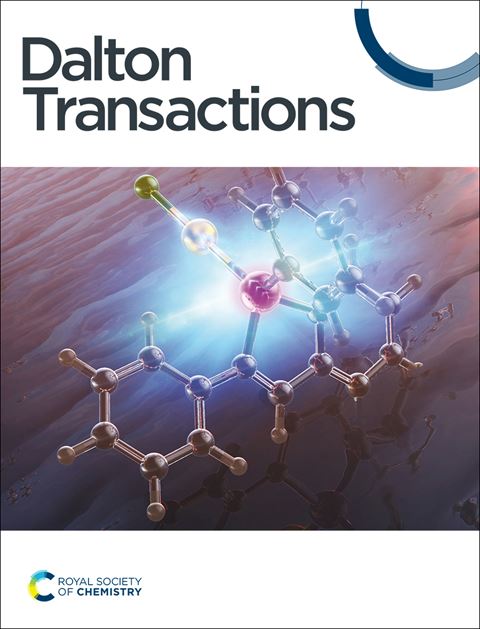基于二硫代氨基甲酸酯的金属配合物对小鼠淋巴瘤的结构见解和体外和体内抗癌评价
IF 3.5
3区 化学
Q2 CHEMISTRY, INORGANIC & NUCLEAR
引用次数: 0
摘要
金属基化疗药物因其干扰细胞功能的能力而受到关注。二硫代氨基甲酸酯配体以其强大的金属结合特性而闻名,已被探索用于抗癌应用的潜力。本研究旨在合成并表征基于二硫代氨基甲酸酯的Ni(II)、Cu(II)和Zn(II)配合物,并评价其对道尔顿淋巴瘤(DL)细胞的抗癌活性。合成了三种二硫代氨基甲酸酯配体(1-3)及其相应的Ni(II)、Cu(II)和Zn(II)配合物(1a-c、2a-c和3a-c),并利用FT-IR、NMR、UV-Vis、质谱和单晶x射线衍射(SC-XRD)对其进行了表征。配合物的TGA分析证实了它们的热稳定性高达150 °C,并在高温下形成金属硫化物。采用MTT法测定这些化合物的体外抗增殖活性。通过Annexin V-FITC/PI染色和流式细胞术分析细胞凋亡诱导情况。在小鼠DL肿瘤模型上进行了体内研究,以评估治疗效果和生物安全性。SC-XRD证实了Ni(II)和Cu(II)配合物呈方形平面几何形状,而Zn(II)配合物呈四面体几何形状。金属配合物1c、2b和3c的抗增殖活性最强,其中1c的IC50最低(7.1 μM)。细胞凋亡分析显示,1c诱导DL细胞凋亡64%。体内研究表明,1c显著降低肿瘤生长,延长生存期,毒性最小。合成的二硫代氨基甲酸盐-金属配合物具有良好的抗癌特性,特别是1c,在体外和体内模型中均表现出优异的疗效。这些发现突出了金属基二硫代氨基甲酸酯作为新型抗癌药物的潜力,需要进一步的临床前研究。本文章由计算机程序翻译,如有差异,请以英文原文为准。
Structural Insights and In Vitro and In Vivo Anticancer Evaluation of Dithiocarbamate-Based Metal Complexes against Murine Lymphoma
Metal-based chemotherapeutics have gained attention due to their ability to interfere with cellular functions. Dithiocarbamate ligands, known for their strong metal-binding properties, have been explored for their potential in anticancer applications. This study aims to synthesize and characterize dithiocarbamate-based Ni(II), Cu(II), and Zn(II) complexes and evaluate their anticancer activity against Dalton’s lymphoma (DL) cells. Three dithiocarbamate ligands (1-3) and their corresponding Ni(II), Cu(II), and Zn(II) complexes (1a-c, 2a-c, and 3a-c) were synthesized and characterized using FT-IR, NMR, UV-Vis, mass spectrometry, and single-crystal X-ray diffraction (SC-XRD). TGA analysis of complexes confirms their thermal stability up to 150 °C and formation of metal sulfides at elevated temperatures. The in vitro antiproliferative activities of these compounds were assessed using the MTT assay. Apoptosis induction was analyzed via Annexin V-FITC/PI staining and flow cytometry. In vivo studies were conducted on a murine DL tumor model to evaluate therapeutic efficacy and biosafety. SC-XRD confirmed square planar geometries for Ni(II) and Cu(II) complexes, whereas Zn(II) complexes exhibited tetrahedral geometry. Metal complexes 1c, 2b, and 3c displayed the most potent antiproliferative activity, with 1c exhibiting the lowest IC50 (7.1 μM). Apoptosis analysis indicated that 1c induced 64% apoptosis in DL cells. In vivo studies demonstrated that 1c significantly reduced tumor growth and prolonged survival, with minimal toxicity. The synthesized dithiocarbamate-metal complexes exhibit promising anticancer properties, particularly 1c, which demonstrated superior efficacy in both in vitro and in vivo models. These findings highlight the potential of metal-based dithiocarbamates as novel anticancer agents warranting further preclinical studies.
求助全文
通过发布文献求助,成功后即可免费获取论文全文。
去求助
来源期刊

Dalton Transactions
化学-无机化学与核化学
CiteScore
6.60
自引率
7.50%
发文量
1832
审稿时长
1.5 months
期刊介绍:
Dalton Transactions is a journal for all areas of inorganic chemistry, which encompasses the organometallic, bioinorganic and materials chemistry of the elements, with applications including synthesis, catalysis, energy conversion/storage, electrical devices and medicine. Dalton Transactions welcomes high-quality, original submissions in all of these areas and more, where the advancement of knowledge in inorganic chemistry is significant.
 求助内容:
求助内容: 应助结果提醒方式:
应助结果提醒方式:


